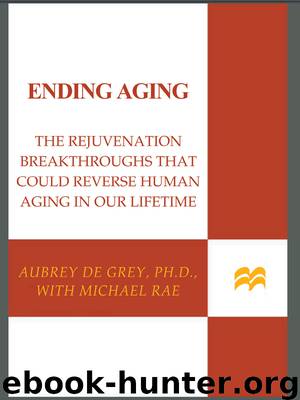Ending Aging by Aubrey de Grey

Author:Aubrey de Grey
Language: eng
Format: epub
Publisher: St. Martin's Press
Published: 2007-07-14T16:00:00+00:00
Know Your Enemy
Today, for the first time in history, we are in the position to design such drugs on a rational basis. Just over a decade ago, when Peter Ulrich and the Alteon chemists were doing the work that ultimately led to the development of alagebrium, they were working in the dark. They didn’t even know for sure that the types of AGE that they were targeting actually existed in the body—they were simply guessing, from studies carried out in test tubes, that such links might form and contribute to stiffening of living tissues. But the new enzyme-based methods that I mentioned earlier now allow us to slowly take tissues apart at the molecular level, layer by layer, revealing the presence and levels of pathological cross-links in our body, exposing our previously hidden opponents to the light of science.
Researchers who have taken the time to develop and apply these new, painstaking procedures to aging human tissues have given us reliable targets on which to fix our crosshairs: a complex structure called glucosepane, which was only identified using these new techniques in 1999,25 and probably another AGE called K2P, which is prominent in the lenses of our eyes and possibly other tissues.26 Glucosepane is the single most important contributor to the body’s AGE burden known to date, tying up as much as one out of every five molecules of the key structural protein collagen in old, nondiabetic humans. Glucosepane levels are around one hundred times as high as that of any other AGE that had previously been found in collagen or the lens. A drug that could free our tissues from these AGE shackles would have a much larger impact on total cross-linking burden than alagebrium does, and would thus bring our tissues much closer to their full youthful flexibility and functionality.
Today, while we will still use the same sort of blackboard molecular engineering that Ulrich and his copanelists did in the early ’90s to design new AGE-breakers, we can fashion molecular bolt-cutters that are precisely tooled to break specific AGEs, whose exact molecular structures are in our possession, and whose presence in our bodies and biomedical significance as major contributors to the total cross-linking of our tissues with age are certainties.
We also have the advantage of having faster screening tools in our possession. We can use software to simulate the behavior of AGE-breakers, and to automate the generation of variations on a core molecular theme. We can put robotics to work to synthesize thousands of ampoules of candidate drugs, and use mechanized, high-throughput techniques to assay their effects against a known culprit in the loss of elasticity in our hearts and other tissues.
Being able to look at glucosepane’s exact chemical structure gives us another advantage in developing its nemesis that Ulrich no doubt wishes he had had so many years ago. The hard part of developing a glucosepane-breaker for clinical use is not identifying chemicals that can destroy it: as we saw earlier, the acids we used in our old AGE-assaying techniques did a regrettably excellent job of it.
Download
This site does not store any files on its server. We only index and link to content provided by other sites. Please contact the content providers to delete copyright contents if any and email us, we'll remove relevant links or contents immediately.
| Biochemistry | Biomedical Engineering |
| Biotechnology |
Whiskies Galore by Ian Buxton(41937)
Introduction to Aircraft Design (Cambridge Aerospace Series) by John P. Fielding(33092)
Small Unmanned Fixed-wing Aircraft Design by Andrew J. Keane Andras Sobester James P. Scanlan & András Sóbester & James P. Scanlan(32763)
Craft Beer for the Homebrewer by Michael Agnew(18196)
Turbulence by E. J. Noyes(7977)
The Complete Stick Figure Physics Tutorials by Allen Sarah(7336)
Kaplan MCAT General Chemistry Review by Kaplan(6899)
The Thirst by Nesbo Jo(6877)
Bad Blood by John Carreyrou(6581)
Modelling of Convective Heat and Mass Transfer in Rotating Flows by Igor V. Shevchuk(6406)
Learning SQL by Alan Beaulieu(6237)
Weapons of Math Destruction by Cathy O'Neil(6214)
Man-made Catastrophes and Risk Information Concealment by Dmitry Chernov & Didier Sornette(5956)
Digital Minimalism by Cal Newport;(5704)
Life 3.0: Being Human in the Age of Artificial Intelligence by Tegmark Max(5512)
iGen by Jean M. Twenge(5384)
Secrets of Antigravity Propulsion: Tesla, UFOs, and Classified Aerospace Technology by Ph.D. Paul A. Laviolette(5332)
Design of Trajectory Optimization Approach for Space Maneuver Vehicle Skip Entry Problems by Runqi Chai & Al Savvaris & Antonios Tsourdos & Senchun Chai(5037)
Pale Blue Dot by Carl Sagan(4953)
